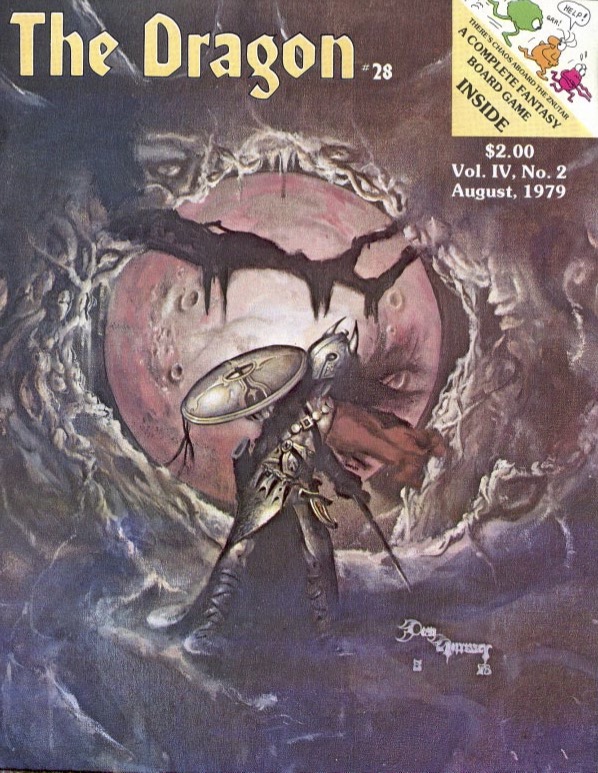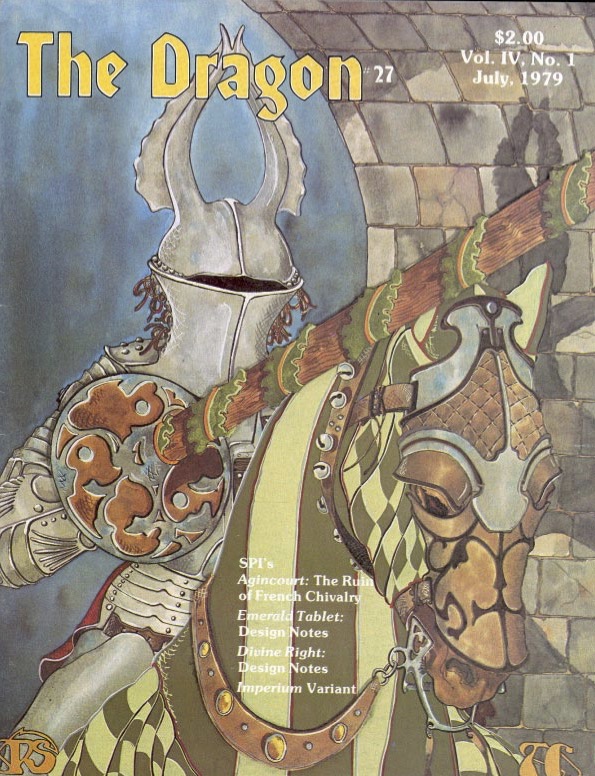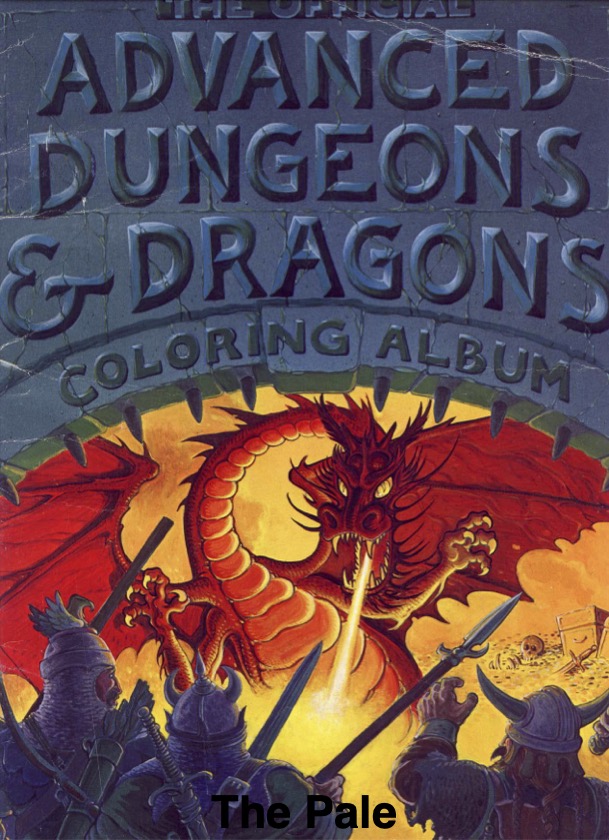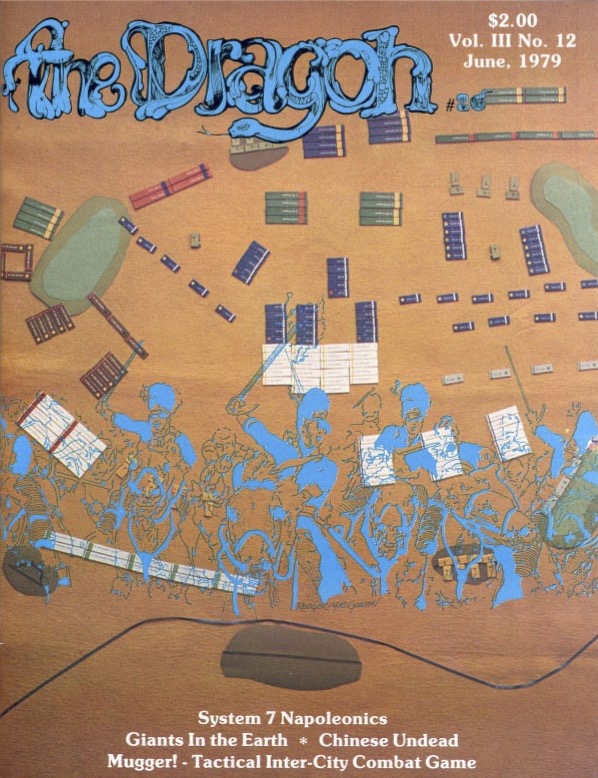2003: Book of Erotic Fantasy
1974 is an important year for the gaming hobby. It is the year that Dungeons & Dragons was introduced, the original RPG from which all other RPGs would ultimately be derived and the original RPG from which so many computer games would draw for their inspiration. It is fitting that the current owner of the game, Wizards of the Coast, released the new version, Dungeons & Dragons, Fifth Edition, in the year of the game’s fortieth anniversary. To celebrate this, Reviews from R’lyeh will be running a series of reviews from the hobby’s anniversary years, thus there will be reviews from 1974, from 1984, from 1994, and from 2004—the thirtieth, twentieth, and tenth anniversaries of the titles. These will be retrospectives, in each case an opportunity to re-appraise interesting titles and true classics decades on from the year of their original release.
—oOo— It is curious to note that in 2003, two supplements were published which addressed the subject of romance, sex, sexuality, pregnancy, and more in roleplaying games—or rather, fantasy roleplaying games. One would pass by almost unnoticed, was written under the terms of the Open Gaming Licence, and was one that I was able to review. The other caused no little controversy, forced Wizards of the Coast to rewrite the terms of the d20 STL forcing publishers to comply with ‘community standards of decency’, has since passed into legend as one of the most notorious books of the roleplaying hobby, and was one that I was not able to review at the time. Indeed, it would take over a decade before a copy could be found and imported into this country—thank you Brendan LaSalle—to enable me to not only own a copy, but review. The one that I could and did review was Naughty And Dice: An Adult Gamer’s Guide to Sexual Situations, published by Sabledrake Enterprises. The one I could not review was the Book of Erotic Fantasy, published by Valar Project. Having forced a rewrite of the d20 STL to prevent Wizards of the Coast from being directly connected to the project and so tarnish its image and reputation, the Book of Erotic Fantasy would eventually published without the d20 System trademark of the Open Gaming Licence, but with the words at the top of the front cover, “This product is compliant with the Open Gaming Licence and is compatible with the world’s best selling Fantasy Roleplaying Game”. Thus, it arrived ready for use with Dungeons & Dragons, Third Edition, but was not specifically written for Dungeons & Dragons, Third Edition.
It is curious to note that in 2003, two supplements were published which addressed the subject of romance, sex, sexuality, pregnancy, and more in roleplaying games—or rather, fantasy roleplaying games. One would pass by almost unnoticed, was written under the terms of the Open Gaming Licence, and was one that I was able to review. The other caused no little controversy, forced Wizards of the Coast to rewrite the terms of the d20 STL forcing publishers to comply with ‘community standards of decency’, has since passed into legend as one of the most notorious books of the roleplaying hobby, and was one that I was not able to review at the time. Indeed, it would take over a decade before a copy could be found and imported into this country—thank you Brendan LaSalle—to enable me to not only own a copy, but review. The one that I could and did review was Naughty And Dice: An Adult Gamer’s Guide to Sexual Situations, published by Sabledrake Enterprises. The one I could not review was the Book of Erotic Fantasy, published by Valar Project. Having forced a rewrite of the d20 STL to prevent Wizards of the Coast from being directly connected to the project and so tarnish its image and reputation, the Book of Erotic Fantasy would eventually published without the d20 System trademark of the Open Gaming Licence, but with the words at the top of the front cover, “This product is compliant with the Open Gaming Licence and is compatible with the world’s best selling Fantasy Roleplaying Game”. Thus, it arrived ready for use with Dungeons & Dragons, Third Edition, but was not specifically written for Dungeons & Dragons, Third Edition.The Book of Erotic Fantasy does not only cover sex and sexuality, but also conception, marriage, love, relationships, and more. That more includes relationships between different species, new Classes and new Prestige Classes, monsters, and organisations. It begins though, by discussing sex. The authors advise that, “Believing it acceptable to expose our audience to a variety of lifestyle choices, we did our best to include the broadest possible array of sexual choices, including celibacy, in the book.” But warn that, “At times, we found it a challenge to keep our own preconceived ideas from creeping in.” As a consequence of this, there is an open attitude to the subject that runs throughout the book, one reflected in a lot of the new mechanics and in some of the choices made by the authors. Further, despite the authors stating that “The world has changed and it is time for fantasy roleplaying to change and mature.”, theirs is not an attitude or outlook that was shared by all, even by their own society. Criticism from those what did not share that outlook was certainly one motivating Wizards of the Coast to rewrite the terms of the d20 STL, despite the authors warning over and over that the Book of Erotic Fantasy is aimed at mature adult audiences.
The supplement really gets underway with a discussion of why sex should be included in the game, how to handle it and roleplaying, and covering subjects such as romance, sex, seduction, sex and humour, and a lot more. It states that the point is not necessarily the sex itself, but rather that sex and romance can be used as means to add spice or flavour to campaign, to help create memorable plots and NPCs, to make it part of the story, and so on. Acknowledged here is that the bawdiness of sexual humour is okay, as it helps keep everyone relaxed, but it has its place. It suggests using the Motion Picture Association film rating system (of 2003) to measure the amount of sex in a campaign, and acknowledges the difficulties of bringing the subject into a game, clearly stating that, “Just as in real life, no means no.” and that relationships between Player Characters can become as fraught as those between adults. It means clear also, that mechanically, sexual orientation has no bearing on game, but like prostitution and marriage, it can have a cultural bearing. How a culture views sexual orientation, prostitution, and marriage varies from one to the next. So, one, two, or more of them might be venerated in one country, even sacred, whereas they might be reviled and even outlawed in another. Again, such attitudes can be used to enforce the cultural outlook of different countries, to bring the world to life, and be the basis of a plot or storyline.
Also worth noting is that any emphasis placed upon sex in a campaign is likely to affect the design of Player Characters and NPCs and that the contents of the Book of Erotic Fantasy are not aimed at the combat veteran or highly skilled wizard. Instead, the need to optimise the Player Character in Dungeons & Dragons, Third Edition will require a campaign of its own, a campaign focused more on social (and now sexual) interaction. In general, the advice and discussion here is decent and mature.
Where the Book of Erotic Fantasy goes slightly awry is in illustrating the views on sex according to the Alignments of Dungeons & Dragons. So, a Lawful Good values honesty and respect and can be celibate or chaste, but when an adherent does have sex outside out of marriage, he is clear in what he expects and is offering, whereas a Lawful Evil simply uses as a means to accrue power. So, the paladin in the accompanying text engages in a romantic encounter, but leaves room for the other participant to withdraw, whereas for Lawful Evil, the character is bloody tyrant engaging sadomasochistic torture. It feels such a shame to have decent advice followed by such clichés. Chaotic Evil does not even get any accompanying text, but then the included quote sums the Alignment up nicely: “Fuck You! No, Fuck You! Fuck You All!” Similarly, though the attitudes of the various Races of Dungeons & Dragons follow expected patterns—Dwarves are conservative, but enduring; Elves are bisexual, adventurous in that they like to share, and have transitory relations over their long lives; Gnomes are even more adventurous, using self-built toys, and writing manuals like the Gnomish Kama Sutra(!); Half-Elves have problems because they mature too early for Elves and too late for Humans; Half-Orcs like it rough; and Halflings view sex like a party. Other Races are covered too, along with how pregnancy and childbirth occurs for each Race, even the Undead and Dragons. These are a bit more inventive though than the sexual backgrounds to the standard Player Character Races.
In terms of new rules, the Book of Erotic Fantasy starts with the addition of Appearance, a new attribute for Dungeons & Dragons, Third Edition, at least, including adding it to all of the Races and species discussed so far. There are rules for sustaining sex, with a rising Constitution Difficulty Check after every ten minutes, and a list of new skills. There is the alternate use of Appraise and Bluff, along with new Knowledge skills and Perform (Sexual Techniques), complete with a table of possible results. Having already looked at the social and biological consequences of sex—marriage and pregnancy—another consequence, the possibility of disease is also discussed, along with a list of fantasy sample diseases. Included among them are Ghoul Fever, Lycanthropy, and Mummy Rot, essentially providing new vectors for old diseases. The others are equally unpleasant, such as Whore’s Delight, which causes the sufferer to excrete a paralysing poison and so freeze the other partner in place (obviously having acquired immunity to it in the meantime), allowing them to be robbed or taken advantage of… Here also, is a table indicating which Race can interbreed with which Race and a variety of new Feats. These are mix of Sexual Feats, such as Dominating Demeanour, Limber, and Quick Recovery; General Feats, like Chaste Life, Seductive, and True Submissive; and Background Feats, for example, Sexually Open Society and Sexually Private Society.
The Classes in the Book of Erotic Fantasy begin with the Imagist, a spellcaster who is both beautiful and reveres beauty itself, wanting to make the world a more beautiful place. The Class casts spells like a Sorcerer, but instead of Charisma, uses Appearance as the spellcasting characteristic. The Class’ spells are a mix of the arcane and the divine. The Kundala Class is similar to the Monk, but with spellcasting abilities derived from its sexual practices. Again, these are a mix of arcane and divine spells, but they can only be cast by a Kundala on others with great difficulty. Where it is not exactly clear how the sexual practices of the Kundala Class affect its spellcasting ability except being presumably lost if not engaged in, the Tantrist Class is more obvious. An arcane spellcaster, the Tantrist inscribes spells as runes on the practitioner’s body and must engage in sex to renew its magical ability, at least for an hour. Which of course, requires a willing partner and a ‘Sustain Sex’ endurance check. The Perform (Sexual Techniques) skill and Endurance Feat add bonuses of course, to the check, as does a high Constitution. Of the three, the Imagist feels underwritten, if not slightly flat; the Kundala Class underwhelming and too similar to the Monk; and the Tantrist, the best explained and possibly the most interesting to play as a flashy spellcaster.
The supplement’s Prestige Classes are the Disciple of Aaluran, the Divine Celibate, the Dominator, the Fey Enticer, Frenzied Disciple, Harem Protector, Knot Binder of Kaladis, Metaphysical Spellshaper, the Pierced Mystic (complete with a eyewatering list of piercing locations), Rake, Sacred Prostitute, and Voyeuristic Seer. The mix manages to be interesting in places as well as both good and bad. It is even unintentionally amusing in places, such as the box of text labelled ‘The Divine Celibate’s Mount’ (which of course, is the unicorn). However, the bad includes the Dominator and the Voyeuristic Seer, both of which are as clichéd and as distasteful as their names suggest. The Voyeuristic Seer is described as “Profoundly visionary or merely prurient, voyeuristic seers might be either or both.”, but definitely feels like the latter and is essentially a specialist in divining and scrying spells, so not that much different to a Wizard that specialises in either. The good includes the Frenzied Disciple, essentially a whirling Dervish-type which uses dance to enhance magical and combat abilities, and the Rake, a classic figure with plenty of roleplaying potential. Most though feel as they are better suited to NPC rather than Player Character use. This includes the Dominator and the Voyeuristic Seer, but is joined by the Harem Protector, which not only needs the Sterile Feat, but be castrated as a eunuch. This is not to say that none of the Prestige Classes in the Book of Erotic Fantasy can be taken by a Player Characters, but rather that some of them cross that line from tasteful to distasteful.
Magic in the Book of Erotic Fantasy includes new Domains, new spells, and new uses for old spells. The Body Domain and the Pleasure Domain are obvious, whereas the Perversion and Voyeur Domains, again, like some of the Prestige Classes seemed suited to NPCs rather than Player Characters. And there are the spells, some of which are amazing, though not in a good way, because this is where the Book of Erotic Fantasy goes awry, not badly awry, but seriously awry. Command can be used to force someone to masturbate or have an orgasm; Cursed Orgasm inflicts damage on the target whenever he has one; Disrobe undresses the target; Grope works in way that Mage Hand does not; Infestation inflicts a sexually transmitted disease on the victim and is accompanied by a ‘delightful’ image of a crotch infested with lover’s lice; Orgasmic Vibrations that can daze a target and force him to miss an action; and Wet Dreams… The problem with all of these spells is that they run counter to the supplement’s opening advice that “Just as in real life, no means no.” as the levels of consent required to include them in a game make their inclusion beggar belief. As does the fact that they are even included in the supplement since without that consent, they all have the potential to amount to sexual assault in one form or another. That potential would vary according to the context and degree of consent, but as written all of these spells are cringeworthily unpleasant. Yet there are spells in the selection which avoid any of this and would even be useful in a standard Dungeons & Dragons game not using the Book of Erotic Fantasy. Mirror Talk and Mirror Walk, for example, as well as Pleasant Dreams to give the target a restful and safe night’s sleep.
The equipment section covers everything from sex toys and aphrodisiacs to birth control devices and services. There are magical items too, including a Ring of Disease Detection, Staff of Holy Pleasure, Ghost Sheath (so you have intercourse with the incorporeal!), and more. It even lists the Book of Erotic Fantasy as an artifact in its own right! The Book of Erotic Fantasy should perhaps, have been on surer ground when it comes sex and deities, since the sexual activities of the gods have always provide fertile grounds for good storytelling, except that the book goes its decided way. Some of the gods, or versions of them, would have a place in many a campaign. For example, Alilial the Childbringer, Midwife to the Gods, Cevelis the Chaste One, Lady of Denial, and Kaladis the Binder, Guardian of the Sacred Vow, all of which are nicely done, but then there is Zanbos the Defiler, the Abusive One, who is the “[D]eity of wanton rape, brutality, and sexual cruelty.” Now it is stated that he is rarely worshipped, but that does not excuse his inclusion because again, it crashes into the supplement’s opening advice that “Just as in real life, no means no.” In a sex-based campaign, like the one that the Book of Erotic Fantasy, there is undoubtedly going to be a need for a dark or villainous or evil god, but the inclusion of Zanbos in this role so obviously, is horrifying.
The bestiary also adds creatures of passion such as Bliss Motes, Cherrubs—both Celestial and Fallen, and templates for variants such as Demonbreed, Devilblooded, Felids (essentially cat people), Feykissed, and more. Some of these do feel more developed than others. Penultimately, the book includes a list of one hundred adventures, all no more than a sentence and all very much in need of development by the Dungeon Master, followed by a handful of sample organisations, such as ‘Damio’s Companionship Service’, an escort service dealing in the exotic, ‘The Velvet Room’, a sample brothel complete with floorplans, and the ‘Seekers of the Eternal Sensation’, a cult of hedonists. All are quite well developed and include NPCs too. The Book of Erotic Fantasy is rounded out with a list of Appearance values for the creatures found in the Dungeons & Dragons, Third Edition core rules, and a ‘What’s New with Phil & Dixie’ comic strip by Phil Foglio, which turns the opinions of games rules lawyers to the subject in hand…
Physically, the Book of Erotic Fantasy is cleanly and tidily presented. Then of course, there is the artwork, which includes photography, much of photo-manipulated, and which does involve a lot of nudity. Whether or not any of its is erotic is in the eye of the beholder, but none of it would have been regarded as being extreme in 2003, though not exactly tasteful, perhaps even a little boring and a little creepy in places, is the worst that can be said of it. Today it all looks a bit tame.
The Book of Erotic Fantasy is definitely a curate’s egg. The advice, given at the beginning of the book, is good. The rest varies wildly in tone and content, but ultimately it comes down to the spells in the book. All too many are distinctly unpleasant in their use and connotations, and indicative of how times have changed where those spells might have been acceptable then, they would not be in the here and now.
In the twenty years since the Book of Erotic Fantasy was published, there can be no doubt that attitudes towards sex and sexuality have changed—both in general and in the gaming hobby. In general, there is a wider acceptance of both and within the hobby, numerous roleplaying games, such as Green Ronin Publishing’s Blue Rose: The Roleplaying Game of Romantic Fantasy and Bully Pulpit Games’ Star Crossed have explored romance and accepted LGBTQ+ characters into the hobby. Yet there really has been no other supplement like the Book of Erotic Fantasy or Naughty And Dice that has reached a wider gaming audience, for the subject of sex—especially in roleplaying—still remains a taboo subject, a subject matter or activity that we rarely want to cross over into and bring into our games. So, in that regard, little has changed. What it would take is a brave group of players—Dungeon Master and players alike—to want to explore and fully embrace what the Book of Erotic Fantasy presents, and it would mean all of the players and the Dungeon Master. After all, the Book of Erotic Fantasy is an ‘all-in, or none in’ kind of supplement. How many such groups there were prepared for what the Book of Erotic Fantasy offered at the time of its publication is debatable, and the same can be said of today. Which leaves the reader to wonder how many actually bought the Book of Erotic Fantasy to use and how many simply bought it for its notoriety? And then to hope that they never learn the answer to that question.
Ultimately, the Book of Erotic Fantasy has three problems. One is its subject matter, which not everyone is comfortable with, which in places is exacerbated by the second, that some of the content is more than enough make the reader recoil in distaste, let alone think about bringing it into play. The third is that its subject matter is very personal, even if the personal is via the construct of a Player Character in a roleplaying game. Not everyone, arguably very few, are willing to engage in the kind of intimacies that the Book of Erotic Fantasy calls for, even if they are the kind of intimacies involving a Player Character rather than the player, in the semi-public sphere of a roleplaying group. So, in 2003 the Book of Erotic Fantasy presented a final frontier that few were prepared to cross, which is understandable given that although it did include a basically mature treatment of sex and sexuality that for the most part belies its reputation, elsewhere its content crossed over into the unpleasant and distasteful for which the supplement fully deserved its reputation for tawdriness and unsavoriness. Ultimately, whilst some of its writing is mature and helpful, the Book of Erotic Fantasy is as unpleasant a book and as useless a book in 2023 as it was in 2003. It was a supplement that whilst fantasy, was very few gamers’ idea of erotic, and that nobody wanted in 2003 and nobody would want in 2023.



.jpg)
















